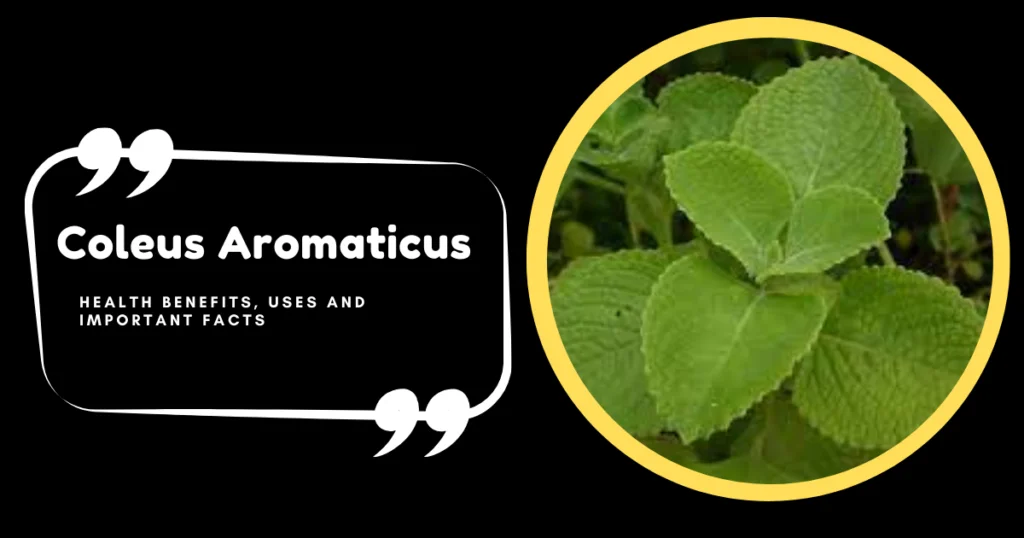Coleus Aromaticus Medicinal Uses and Benefits – A 2025 Comprehensive Guide
Coleus aromaticus, commonly known as Panikoorka, is a highly valued medicinal herb with a long history in traditional medicine. Also referred to as “Indian Borage,” “Mexican Mint,” “Country Borage,” and “Karpooravalli” in various languages, this aromatic plant is widely used for its therapeutic properties. In recent years, the growing interest in herbal medicine and natural remedies has increased its popularity in the United States and other parts of the world.
Coleus Aromaticus Benefits: Why Is It Gaining Popularity?
Coleus aromaticus is renowned for its diverse health benefits. It is rich in bioactive compounds such as flavonoids, tannins, and essential oils, making it an effective natural remedy for various ailments. Some key benefits include:
- Respiratory Health – One of the most well-known uses of Coleus aromaticus is its ability to relieve respiratory issues. It acts as a natural expectorant, helping clear mucus and ease conditions like colds, coughs, asthma, and bronchitis.
- Anti-inflammatory Properties – The plant contains powerful anti-inflammatory compounds that help reduce swelling and discomfort in conditions like arthritis and joint pain.
- Antibacterial and Antifungal Effects – Coleus aromaticus has strong antimicrobial properties, making it effective against bacterial and fungal infections, including skin infections and respiratory tract infections.
- Digestive Aid – This herb is known to support digestive health by reducing bloating, indigestion, and acidity. It also helps alleviate stomach cramps and supports gut health.
- Fever Reduction – A traditional home remedy involves applying crushed leaves of Coleus aromaticus on the forehead to reduce fever, particularly in children.
- Skin Health – Due to its antiseptic and healing properties, Coleus aromaticus is used to treat wounds, insect bites, rashes, and minor burns.
- Immune System Booster – Rich in antioxidants, this herb strengthens the immune system and protects the body from infections and oxidative stress.
- Pain Relief – Coleus aromaticus is often used to alleviate headaches, toothaches, and minor body aches when applied topically or consumed as herbal tea.
Why is Panikoorka (Coleus Aromaticus) So Popular?
The popularity of panikoorka can be attributed to its impressive array of health benefits, which include:
1. Respiratory Health: Panikoorka is renowned for its efficacy in relieving respiratory ailments. It acts as a natural expectorant, helping to clear mucus from the airways. It is commonly used for treating coughs, colds, asthma, and bronchitis.
2. Antibacterial Properties: Panikoorka exhibits antibacterial and antimicrobial properties, making it effective in fighting infections, including those of the respiratory tract.
3. Digestive Aid: It aids digestion and can be used to alleviate stomach discomfort, indigestion, and gas.
4. Anti-inflammatory: The anti-inflammatory properties of panikoorka make it useful in reducing swelling and inflammation associated with conditions like arthritis.
5. Skin Care: Panikoorka can be applied topically to soothe skin conditions such as insect bites, rashes, and minor burns.
6. Fever Reducer: It is traditionally used to lower fever in children by applying a poultice of crushed leaves to the forehead.
7. Antioxidant Rich: Panikoorka is a good source of antioxidants, which help combat free radicals and oxidative stress in the body.
8. Pain Relief: It may be used to alleviate headaches, toothaches, and general pain.
9. Culinary Uses: Panikoorka leaves are also used in cooking, adding a unique flavor to various dishes.
How is Panikoorka (Coleus Aromaticus) Used?
Panikoorka can be used in various forms:
1. Fresh Leaves: Chewing fresh leaves is a common method for alleviating coughs and colds. The leaves can also be used in cooking, similar to other culinary herbs.
2. Herbal Decoction: A decoction made from panikoorka leaves is used to treat respiratory issues. Simply boil the leaves in water until it reduces to half, strain, and drink.
3. Poultice: Crushed leaves can be applied topically as a poultice to soothe skin irritations or reduce fever.
4. Essential Oil: Panikoorka essential oil is available and can be diluted and used for massage or added to steam inhalations.
5. Syrup: Panikoorka syrup is a commercially available preparation used for coughs and colds.
6. Powder: Dried panikoorka leaves can be ground into a fine powder and consumed with honey or warm water.
Coleus Aromaticus in the USA: Growing Interest and Usage
In recent years, Coleus aromaticus has gained widespread popularity in the United States, particularly among herbalists, wellness enthusiasts, and those exploring natural alternatives for common health issues. The increasing awareness of Ayurveda and traditional herbal medicine has fueled demand for this plant.
- Health-conscious consumers in the U.S. are now incorporating Coleus aromaticus into their diet as an herbal tea or supplement.
- Holistic health practitioners recommend its use for respiratory and digestive wellness.
- Culinary enthusiasts have started adding its aromatic leaves to dishes for enhanced flavor and health benefits.
- Organic farms and herbal stores are now offering fresh and dried Coleus aromaticus leaves due to its rising demand.
Coleus Aromaticus Medicinal Uses: How to Use It Effectively
1. As a Herbal Tea
- Boil fresh or dried Coleus aromaticus leaves in water.
- Let it steep for 5-10 minutes.
- Strain and drink to relieve colds, coughs, and digestive discomfort.
2. Poultice for Skin Issues
- Crush fresh leaves and apply directly to wounds, insect bites, or rashes.
- Leave for 10-15 minutes before rinsing.
3. Steam Inhalation for Respiratory Relief
- Boil leaves in water and inhale the steam to clear nasal congestion and respiratory passages.
4. Essential Oil for Massage and Aromatherapy
- Dilute Coleus aromaticus essential oil with carrier oil.
- Apply to joints for pain relief or use in a diffuser for relaxation.
5. In Cooking
- Use fresh leaves to flavor soups, curries, and herbal-infused drinks.
6. As a Fever Remedy
- Crush fresh leaves and apply as a paste on the forehead to reduce fever naturally.
Scientific Studies and Ongoing Research
Recent scientific studies have begun validating the traditional uses of Coleus aromaticus. Research indicates that its antibacterial and anti-inflammatory properties are beneficial in treating infections and chronic inflammatory conditions. Ongoing studies are also exploring its potential in respiratory therapies and immune support.
Precautions and Side Effects
While Coleus aromaticus is generally safe for consumption and topical use, the following precautions should be noted:
- Pregnant and breastfeeding women should consult a healthcare provider before use.
- Allergic reactions such as itching or skin irritation may occur in some individuals.
- Excessive consumption may cause stomach discomfort or mild nausea.
Important Facts About Panikoorka
1. Precautions: While panikoorka is generally safe when used in recommended amounts, excessive consumption or application can lead to adverse effects. It’s advisable to consult a healthcare professional or Ayurvedic practitioner before using it as a remedy, especially during pregnancy or for young children.
2. Allergic Reactions: Some individuals may be allergic to panikoorka. If you experience any adverse reactions like itching, rashes, or swelling, discontinue use immediately.
3. Culinary Uses: In addition to its medicinal properties, panikoorka leaves are used to flavor traditional dishes in South Indian cuisine, adding a unique taste to curries and chutneys.
4. Scientific Research: While panikoorka has a rich history in traditional medicine, more scientific research is needed to validate its various health claims fully.
Final Thoughts: The Versatile Herb for Natural Wellness
Coleus aromaticus continues to be a valuable medicinal herb with a rich history and promising health benefits. With increasing recognition in the U.S. and global markets, this traditional remedy is now more accessible for those seeking natural wellness solutions. Whether used for respiratory health, digestion, or skin care, this herb remains an essential component of holistic healing practices.
By integrating Coleus aromaticus into daily life, individuals can harness its potent health benefits while embracing a time-honored tradition of herbal medicine.






